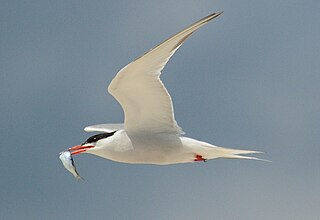
Terns are seabirds in the family Laridae that have a worldwide distribution and are normally found near the sea, rivers, or wetlands. Terns are treated as a subgroup of the family Laridae which includes gulls and skimmers and consists of eleven genera. They are slender, lightly built birds with long, forked tails, narrow wings, long bills, and relatively short legs. Most species are pale grey above and white below, with a contrasting black cap to the head, but the marsh terns, the Inca tern, and some noddies have dark plumage for at least part of the year. The sexes are identical in appearance, but young birds are readily distinguishable from adults. Terns have a non-breeding plumage, which usually involves a white forehead and much-reduced black cap.

The Arctic tern is a tern in the family Laridae. This bird has a circumpolar breeding distribution covering the Arctic and sub-Arctic regions of Europe, Asia, and North America. The species is strongly migratory, seeing two summers each year as it migrates along a convoluted route from its northern breeding grounds to the Antarctic coast for the southern summer and back again about six months later. Recent studies have shown average annual round-trip lengths of about 70,900 km (44,100 mi) for birds nesting in Iceland and Greenland and about 48,700 km (30,300 mi) for birds nesting in the Netherlands. These are by far the longest migrations known in the animal kingdom. The Arctic tern nests once every one to three years.

The common tern is a seabird in the family Laridae. This bird has a circumpolar distribution, its four subspecies breeding in temperate and subarctic regions of Europe, Asia and North America. It is strongly migratory, wintering in coastal tropical and subtropical regions. Breeding adults have light grey upperparts, white to very light grey underparts, a black cap, orange-red legs, and a narrow pointed bill. Depending on the subspecies, the bill may be mostly red with a black tip or all black. There are several similar species, including the partly sympatric Arctic tern, which can be separated on plumage details, leg and bill colour, or vocalisations.

Forster's tern is a tern in the family Laridae. The genus name Sterna is derived from Old English "stearn", "tern", and forsteri commemorates the naturalist Johann Reinhold Forster.

The name marsh tern refers to terns of the genus Chlidonias, which are typically found in freshwater marshes, rather than coastal locations. The genus name Chlidonias is from Ancient Greek khelidonios, "swallow-like", from khelidon, "swallow".

The black-naped tern is an oceanic tern mostly found in tropical and subtropical areas of the Pacific and Indian Oceans. It is rarely found inland.

Kloa Point is a prominent coastal point projecting from the east side of Edward VIII Plateau, 5.6 kilometres (3 nmi) north of Cape Gotley, Antarctica. It was mapped by Norwegian cartographers from aerial photographs taken by the Lars Christensen Expedition, 1936–37, and called by them Kloa ('claw').
Apocreadiidae is a family of parasitic worms in the class Trematoda.

Haploporidae is a family of trematodes in the order Plagiorchiida.

Capsalidae is a family of monopisthocotylean monogeneans, which includes about 200 species.

Sterna Linhas Aéreas was a cargo airline based in Curitiba, Brazil, founded in 2014. It operated cargo services.
Philophthalmidae is a family of trematodes in the order Plagiorchiida.

Tephritini is a tribe of fruit flies in the family Tephritidae. There are about 80 genera and some 1000 described species in Tephritini.
Strigeidae is a family of trematodes in the order Diplostomida.

Diplostomidae is a family of trematodes in the order Diplostomida.
Cyathocotylidae is a family of trematodes in the order Diplostomida.
Parastrigea is a genus of trematodes in the family Strigeidae.
Holostephanus is a genus of parasitic trematodes in the family Cyathocotylidae.
Holostephanus dubinini is a species of parasitic trematode in the family Cyathocotylidae.











